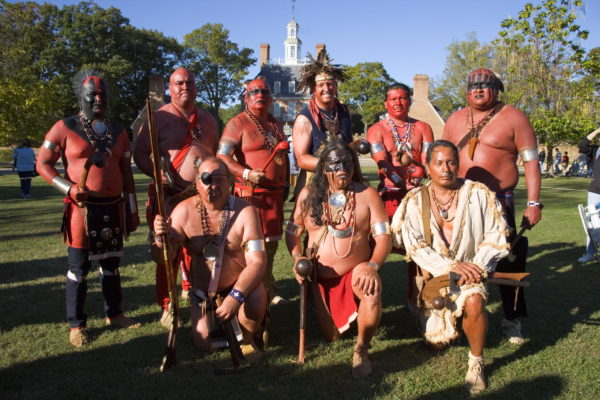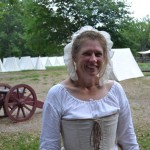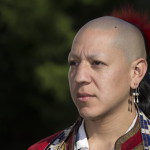
In late May of 1777, in the midst of the Revolutionary War, a delegation of Cherokee came to Williamsburg to meet with Patrick Henry, Virginia’s governor. The Cherokee had been coming to the colonial capital for decades, but this trip was different. They were facing their own crisis.
The Cherokee were a part of the fabric of life in Williamsburg. Along with their periodic diplomatic visits, they were trading partners and distant neighbors. Violent conflicts were part of the relationship, but far from the whole story.
The impending visit was made public on May 16 when Mr. Purdie’s Virginia Gazette delivered the news that more than 40 Cherokee were expected in a matter of days, and wanted an audience with the governor and his council.
It was a long journey. Their hometown of Chota was some 500 miles west of Williamsburg (about 50 miles south of modern-day Knoxville, Tenn.). Chota was Williamsburg’s Overhill Cherokee counterpart, in a sense, serving as a political and diplomatic capital. It was also the end point of trade routes to and from coastal cities.
While Virginia was mobilizing for battle with the British, the Cherokee had been losing a war of attrition for decades. Treaties and proclamations, such as George III’s 1763 decree prohibiting colonial settlement west of the Proclamation Line along the Appalachians, had failed to deter settlers intent on occupying land.
Some Indians practically gave away land to relieve debt, or in return for needed goods. A British agent in Chota reported Cherokee leaders complaining that could “see the smoke of the Virginians from their doors.” And as Cherokee resentments were rising, their numbers were dwindling.
At the outset of the American Revolution, many Native Americans saw the opportunity to forge an alliance that would push the Americans off Native lands. A group of militant Shawnee, Mohawks, and Ottawas persuaded a young generation of warriors led by Dragging Canoe to take up the hatchet against vulnerable white settlements. As it happened, Dragging Canoe had received 3,000 pounds of gunpowder from the British which could now be put to use, though it wouldn’t be nearly enough.
As the young warriors sang and danced to mark their acceptance of the nine-foot long war belt “strewn over with vermilion,” the Cherokee leaders sat silently.
The people of Williamsburg were so far unaware of these dangerous developments on the frontier. But later in 1776, along with learning of the passage of the Declaration of Independence and Washington’s retreat from New York, readers of the Virginia Gazette read about Cherokee “butchering parties” and “ruined settlers” on the frontier.
And then they read about the retaliatory strikes that took place from Virginia to Georgia. Col. William Christian (Gov. Henry’s brother-in-law), led Virginia militiamen who “utterly destroyed” three towns under the influence of Dragging Canoe. Christian spared Chota, perhaps because he knew the Great Men of that town had opposed the conflict.
So that was the challenge faced by the Cherokee delegation. They were finding it almost impossible to stay out of the fray, facing pressure from neighboring Native nations, the British, and the colonies to take a side. A fragile peace would be negotiated in July 1777, which only exacerbated the internal divisions among the Cherokee.
The delegation to Williamsburg was led by Oconostota, who became tribal chief in 1768. He was accompanied by Attakullaculla (also known as Little Carpenter) who was Dragging Canoe’s father. Attakullaculla was old enough that he had paid a visit to George II in London back in 1730. They were joined by another headman, the Pigeon, as well as other warriors and women.
Which leads us to the Return of the Cherokee programming which marks the important events of 1777.
With so many people in their company, the Cherokee set up camp somewhere on the edge of town. That encampment will be recreated at the corner of Nicholson and Botetourt streets, with tents, fires, and lots of activity. Visitors to the Camp of the Cherokee will have the rare opportunities to learn about the history and culture of a people who were much more familiar in many ways to 18th-century Virginians than they are to us today. It’s open daily from June 1-5.
Colonial Williamsburg’s American Indian interpreters will be joined by members of the Eastern Band of Cherokee, the Cherokee Nation of Oklahoma, and the Keetoowah Band of Cherokee from Oklahoma, who will be eager to offer their unique perspectives, and will be demonstrating aspects of their traditional material culture, skills like basketmaking, weaving, and woodcarving.
On the Cherokee Trader Tour (June 2), take a journey through town with a trader back from the frontier as he conducts his business in town. Learn about the network of connections he has to maintain with merchants, politicians, and other members of the community to make a living. Ask him how different Chota is from Williamsburg. (The Indian Trader Tour is also a regularly featured program.)
Buck Woodard, who heads Colonial Williamsburg’s American Indian Initiative, will lead a special once-a-year walking tour, In the Footsteps of Diplomats, on Friday, June 3. For anyone interested in the big picture of Cherokee relations and visits to the colonial capital, this promises to be an invaluable overview.
The Cherokee’s Public Dance will be interpreted on Saturday and Sunday afternoons on Palace Green, the same place it originally occurred. Gov. Patrick Henry and some of the Council members will be on hand to talk about the fruits of their diplomatic talks.
The dances are offered as part of the exchange of gifts that were part of any diplomatic conversation. They will feature a war dance in full paint to begin, followed by social dances. The audience will be invited to take part. And although the dances that will be performed do not actually date to the 18th century, they promise to capture the spirit of that moment when the Cherokee and the Virginians found some common ground.
A more intimate version of the dances are central to an evening program on Saturday. Friends and Brethren: Cherokee Storytelling and Dance will include stories and dances from the Eastern Band of Cherokee.
The word “return” is significant. It speaks to the fact that Virginia Indians visited the colonial capital regularly in the 1700s: to trade, to conduct diplomacy, and some, of course, to attend the Brafferton School. Today, we’re getting better at making them part of the town. The people of 18th-century Williamsburg, after all, were accustomed to seeing them. We should be too.




This is totally awesome! I tegret that I mossed it!
Hopefully, i can catch this next year.
These type of living histories helps our nation as we can destroy ignorance with education.
However, a few of the comments here prove beyond a doubt, that we still haven’t found a cure for stupid.
Keep up the great work!
Excellent piece, Bill, on a topic that is too often overlooked. I have relatives who live near Knoxville. Now I know the origin of the name “Chota,” which is common in that area.
Barb Dailey says
I love Colonial Williamsburg and have the utmost respect for what you do. I mean no disrespect but were the Cherokees all overweight? It seems to me that in the late 1700s, if a man was lazy and didn’t take part and allowed himself to become obese, it wasn’t tolerated by the tribe. I can’t imagine a Cherokee man looking like this. And, again, this is just my opinion, but this pic is laughable. I guess I expected more authenticity from CW.
Thank you for reading the post. I don’t actually know anything about the weight of 18th-century Indians. I do think it’s a mistake to focus on the participants’ bodies (or, for that matter, to equate obesity with laziness). Colonial Williamsburg’s authenticity is rooted in how we interpret, perform, and present the past. These gentlemen, who are members of the Eastern Cherokee, join us each year to do their part for Native American history. We have the utmost regard for them, and how they present this story, and to me their presence is about as authentic as anything could be.
Jamie says
Thank you Bill, Well said.
And no, obseity was not prevelant in any of our Native nations pre-European arrival or in the 18th or 19th centuries.
Paul Jones says
Well, said Ms. Dailey,
This is a major faule with all 18th century re-enacting.
Paul Jones says
Well, said Ms. Dailey,
This is a major fault with all 18th century re-enacting.
Jamie says
Wow Barb.
After reading that article which provides great historical perspective and information, you choose to focus on and critique these contemporary Cherokee’ s weight ???
I hope you ask that same question to all the obese European settler actors/actresses at Colonial Williamsburg.
I hope CW plans on filming many of the programs during this 5 day event. Those of us that can’t be there would really appreciate the effort.
I took the Indian Trader tour. It was so interesting and enlightening. Highly recommend it!
My wife and I took in the Indian Trader Tour in April also. It was well done and very informative. The Indian interpreters were fantastic. Answered all our questions with dignity and grace. Another ackcomplishment by CW!
Oh how I wish I could come see this. My 3x Great Grandmother was 1/2 Cherokee.
Good to see you are remembering these important people. The story of what has happened, and is still happening to Native Americans in this country is the great tragedy of our nation.